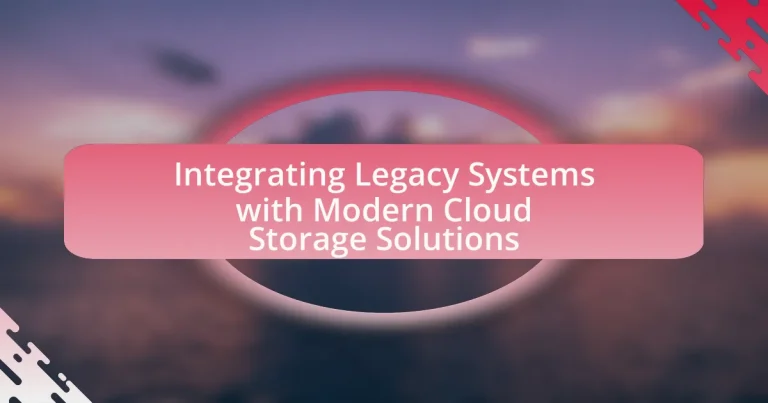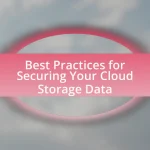Integrating legacy systems with modern cloud storage solutions is a critical process for organizations seeking to enhance operational efficiency and data accessibility. Legacy systems, characterized by outdated technology and high maintenance costs, often hinder integration with newer solutions. Modern cloud storage offers scalability, flexibility, and advanced security features, making it essential for organizations to transition effectively. This article explores the differences between legacy systems and cloud solutions, the challenges of integration, key considerations for successful implementation, and best practices to ensure a smooth transition while maintaining data integrity and security.
What are Legacy Systems and Modern Cloud Storage Solutions?
Legacy systems are outdated computing systems or applications that are still in use, often due to their critical role in business operations, despite being less efficient and lacking modern features. These systems typically rely on older technology, making them difficult to integrate with newer solutions. Modern cloud storage solutions, on the other hand, utilize internet-based storage services that offer scalability, flexibility, and accessibility, allowing users to store and manage data remotely. The transition from legacy systems to modern cloud storage can enhance operational efficiency, as cloud solutions often provide advanced features such as real-time data access, automated backups, and enhanced security measures.
How do legacy systems differ from modern cloud storage solutions?
Legacy systems primarily rely on on-premises infrastructure and often involve outdated technology, while modern cloud storage solutions utilize scalable, internet-based platforms that offer flexibility and accessibility. Legacy systems typically require significant maintenance and are less adaptable to new technologies, whereas cloud storage solutions provide automatic updates, enhanced security features, and the ability to access data from anywhere. For instance, a study by Gartner indicates that organizations using cloud solutions can reduce IT costs by up to 30% compared to maintaining legacy systems, highlighting the efficiency and cost-effectiveness of modern cloud storage.
What are the defining characteristics of legacy systems?
Legacy systems are characterized by their outdated technology, limited integration capabilities, and reliance on older programming languages. These systems often operate on obsolete hardware and software, making them difficult to maintain and upgrade. Additionally, legacy systems typically lack compatibility with modern applications and cloud solutions, which hinders data sharing and interoperability. Their architecture is often monolithic, leading to challenges in scalability and flexibility. Furthermore, legacy systems may have high operational costs due to inefficient processes and the need for specialized knowledge to manage them.
What features distinguish modern cloud storage solutions?
Modern cloud storage solutions are distinguished by features such as scalability, accessibility, security, and integration capabilities. Scalability allows users to adjust storage capacity according to their needs, enabling efficient resource management. Accessibility ensures that data can be accessed from any location and device with internet connectivity, facilitating remote work and collaboration. Security features, including encryption and multi-factor authentication, protect sensitive data from unauthorized access. Additionally, integration capabilities enable seamless connectivity with legacy systems and other applications, enhancing operational efficiency and data flow. These features collectively enhance user experience and operational effectiveness in various business environments.
Why is integrating legacy systems with modern cloud storage important?
Integrating legacy systems with modern cloud storage is important because it enhances data accessibility and operational efficiency. Legacy systems often contain critical data and functionalities that organizations rely on, but they may lack the scalability and flexibility of modern cloud solutions. By integrating these systems, organizations can leverage cloud storage’s capabilities, such as real-time data access, improved collaboration, and cost-effectiveness. For instance, a study by McKinsey & Company found that companies that effectively integrate legacy systems with cloud solutions can reduce operational costs by up to 30% while improving data retrieval times significantly. This integration not only preserves valuable legacy investments but also positions organizations to innovate and adapt to changing market demands.
What challenges do organizations face with legacy systems?
Organizations face several challenges with legacy systems, including high maintenance costs, lack of integration capabilities, and difficulty in finding skilled personnel. High maintenance costs arise because legacy systems often require specialized knowledge and outdated hardware, leading to increased operational expenses. Lack of integration capabilities makes it challenging to connect these systems with modern technologies, hindering data flow and process efficiency. Additionally, the scarcity of skilled personnel familiar with outdated technologies complicates system updates and support, further exacerbating operational inefficiencies. These challenges collectively impede organizations from leveraging modern cloud storage solutions effectively.
How can modern cloud storage address these challenges?
Modern cloud storage can address the challenges of integrating legacy systems by providing scalable, flexible, and secure data management solutions. These cloud platforms enable seamless data migration and integration through APIs and connectors that facilitate communication between legacy systems and cloud environments. For instance, cloud storage solutions often support various data formats and protocols, allowing organizations to access and utilize legacy data without extensive modifications. Additionally, cloud storage offers enhanced security features, such as encryption and access controls, which protect sensitive data during the integration process. This capability is crucial as it ensures compliance with data protection regulations while maintaining data integrity.
What are the key considerations for integration?
Key considerations for integration include compatibility, data migration, security, and user training. Compatibility ensures that legacy systems can effectively communicate with modern cloud solutions, often requiring middleware or APIs. Data migration involves transferring existing data to the new system without loss or corruption, necessitating thorough planning and testing. Security is critical, as integrating systems can expose vulnerabilities; thus, implementing robust security measures is essential. User training is necessary to ensure that staff can effectively utilize the new integrated system, which can enhance productivity and reduce resistance to change.
What are the technical requirements for integrating legacy systems with cloud storage?
The technical requirements for integrating legacy systems with cloud storage include compatibility with APIs, data transformation capabilities, secure data transfer protocols, and adequate network bandwidth. Legacy systems must support application programming interfaces (APIs) to facilitate communication with cloud services, ensuring that data can be accessed and manipulated effectively. Data transformation capabilities are essential to convert legacy data formats into formats compatible with cloud storage solutions. Secure data transfer protocols, such as HTTPS or SFTP, are necessary to protect data during transmission. Additionally, sufficient network bandwidth is required to handle the volume of data being transferred to and from the cloud, ensuring efficient integration and performance.
What types of data formats need to be considered?
Data formats that need to be considered include structured formats like CSV and JSON, semi-structured formats such as XML, and unstructured formats like text files and multimedia files. These formats are essential for ensuring compatibility between legacy systems and modern cloud storage solutions. For instance, CSV is widely used for tabular data, while JSON is favored for web applications due to its lightweight nature. XML provides a flexible way to store and transport data, making it suitable for various applications. Unstructured formats, including images and videos, require specific handling to integrate effectively with cloud storage.
How do APIs facilitate integration between systems?
APIs facilitate integration between systems by providing standardized protocols that allow different software applications to communicate and exchange data seamlessly. This interoperability enables legacy systems to connect with modern cloud storage solutions, ensuring that data can flow between them without requiring extensive modifications to either system. For instance, RESTful APIs use HTTP requests to enable data retrieval and manipulation, which is crucial for integrating older systems with newer technologies. This capability is supported by the fact that APIs can handle various data formats, such as JSON and XML, making it easier to bridge the gap between disparate systems.
What security measures should be taken during integration?
During integration, implementing robust security measures is essential to protect data and systems. Key measures include using encryption for data in transit and at rest, ensuring secure authentication methods such as multi-factor authentication, and conducting regular security assessments to identify vulnerabilities. Additionally, employing access controls to limit user permissions and utilizing firewalls to monitor and filter incoming and outgoing traffic are critical. According to the 2021 Verizon Data Breach Investigations Report, 61% of breaches involved credential theft, highlighting the importance of strong authentication and access management during integration processes.
How can data integrity be maintained during the transition?
Data integrity can be maintained during the transition by implementing robust data validation processes and ensuring consistent data backups. These measures help to verify that data remains accurate and unaltered throughout the migration process. For instance, using checksums or hash functions can detect any discrepancies in data before and after the transition, ensuring that the information transferred from legacy systems to modern cloud storage solutions is intact. Additionally, conducting thorough testing and validation of the data in the new environment before fully switching over can further safeguard against data loss or corruption.
What role does encryption play in securing data?
Encryption plays a critical role in securing data by transforming it into an unreadable format that can only be accessed by authorized users with the correct decryption key. This process protects sensitive information from unauthorized access, ensuring confidentiality and integrity during data transmission and storage. For instance, the use of Advanced Encryption Standard (AES) is widely recognized for its effectiveness in safeguarding data, as it employs symmetric key encryption to secure information against potential breaches. According to the National Institute of Standards and Technology (NIST), encryption is essential for protecting data in transit and at rest, making it a fundamental component of modern cybersecurity strategies.
What are the best practices for successful integration?
The best practices for successful integration of legacy systems with modern cloud storage solutions include thorough planning, clear communication, and incremental implementation. Thorough planning involves assessing the existing legacy systems and defining integration goals, which ensures alignment with business objectives. Clear communication among stakeholders facilitates understanding of requirements and expectations, reducing the risk of misalignment. Incremental implementation allows for testing and adjustments at each stage, minimizing disruptions and ensuring that the integration process is manageable. These practices are supported by industry reports indicating that organizations employing structured integration strategies experience up to 30% faster deployment times and improved system performance.
How can organizations prepare for the integration process?
Organizations can prepare for the integration process by conducting a thorough assessment of their existing legacy systems and identifying the specific requirements for integration with modern cloud storage solutions. This assessment should include evaluating data compatibility, system architecture, and potential security vulnerabilities. For instance, a study by Gartner indicates that 70% of organizations that fail to assess their legacy systems adequately encounter significant integration challenges, leading to increased costs and project delays. By understanding these factors, organizations can develop a strategic integration plan that addresses technical and operational needs, ensuring a smoother transition to cloud-based solutions.
What steps should be taken to assess current systems?
To assess current systems, organizations should conduct a comprehensive evaluation that includes inventorying existing hardware and software, analyzing system performance, and identifying integration capabilities with modern cloud solutions. This process begins with creating a detailed inventory of all legacy systems, which allows for a clear understanding of what is currently in use. Next, performance metrics should be analyzed to determine how well these systems meet current operational needs, including uptime, speed, and user satisfaction. Finally, organizations must assess the compatibility of legacy systems with potential cloud storage solutions, focusing on data migration paths, API availability, and security protocols. This structured approach ensures that organizations can effectively identify gaps and opportunities for integration with modern technologies.
How can stakeholder involvement enhance the integration process?
Stakeholder involvement enhances the integration process by ensuring that diverse perspectives and requirements are considered, leading to more effective solutions. Engaging stakeholders, such as end-users, IT staff, and management, facilitates the identification of potential challenges and opportunities early in the integration of legacy systems with modern cloud storage solutions. Research indicates that projects with active stakeholder participation are 30% more likely to succeed, as they foster collaboration and alignment on goals, which is crucial for addressing the complexities of integration.
What common pitfalls should be avoided during integration?
Common pitfalls to avoid during integration of legacy systems with modern cloud storage solutions include inadequate planning, lack of stakeholder involvement, and insufficient testing. Inadequate planning can lead to misalignment between business goals and technical capabilities, resulting in project delays and increased costs. Lack of stakeholder involvement often results in missed requirements and user needs, which can compromise the effectiveness of the integration. Insufficient testing can lead to undetected issues that may arise post-deployment, causing disruptions in operations. According to a study by the Project Management Institute, 39% of projects fail due to a lack of clearly defined objectives and stakeholder engagement, highlighting the importance of addressing these pitfalls.
How can inadequate planning impact the integration outcome?
Inadequate planning can lead to significant failures in the integration outcome of legacy systems with modern cloud storage solutions. Poorly defined objectives and lack of a clear strategy can result in misalignment between the legacy systems and cloud technologies, causing data loss, increased downtime, and operational inefficiencies. For instance, a study by McKinsey & Company found that 70% of digital transformation projects fail due to insufficient planning and execution. This highlights the critical need for thorough planning to ensure compatibility, data integrity, and a smooth transition, ultimately affecting the overall success of the integration process.
What are the risks of neglecting user training and support?
Neglecting user training and support poses significant risks, including decreased productivity, increased errors, and user frustration. When users lack proper training, they may struggle to effectively utilize integrated legacy systems with modern cloud storage solutions, leading to inefficiencies. A study by the International Data Corporation found that organizations can lose up to 20-30% of their productivity due to inadequate training. Furthermore, without ongoing support, users may become disengaged, resulting in higher turnover rates and increased costs associated with hiring and training new staff. These factors collectively hinder the successful integration of legacy systems, ultimately impacting organizational performance and return on investment.
What are some practical tips for integrating legacy systems with modern cloud storage solutions?
To effectively integrate legacy systems with modern cloud storage solutions, organizations should prioritize the use of APIs and middleware to facilitate communication between the two environments. Utilizing APIs allows for seamless data exchange, while middleware can help bridge compatibility gaps, ensuring that legacy applications can interact with cloud services without extensive rewrites. Additionally, conducting a thorough assessment of existing data structures and workflows is crucial; this enables organizations to identify which data can be migrated to the cloud and which processes need to remain on-premises. Implementing a phased migration strategy can also minimize disruptions, allowing for gradual integration and testing of functionalities. Finally, ensuring robust security measures and compliance protocols are in place is essential to protect sensitive data during the integration process.


